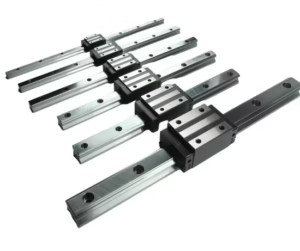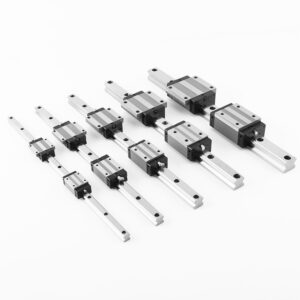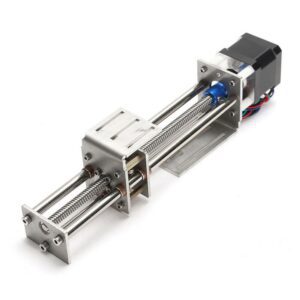Outline for “CNC Linear Slide”
| Main Heading | Sub-Headings |
|---|---|
| Introduction to CNC Linear Slide | Evolution of linear motion, Importance in CNC systems |
| What is a CNC Linear Slide? | Definition, Core components, Basic working principle |
| Types of CNC Linear Slides | Ball-type slide, Roller-type slide, Air bearing slides |
| Materials Used in CNC Linear Slide | Stainless steel, Aluminum, Composite coatings |
| Design Features of CNC Linear Slide | Rails, Blocks, Preload adjustment, Sealing |
| How CNC Linear Slide Works | Motion transfer, Friction control, Load handling |
| Advantages of CNC Linear Slide | Precision, Durability, High-speed capability |
| Applications of CNC Linear Slide | CNC milling, Laser cutting, 3D printing, Medical robotics |
| CNC Linear Slide in CNC Milling Machines | Role in accuracy, Surface finishing benefits |
| CNC Linear Slide for 3D Printing | Improving print precision, Smooth axis movement |
| CNC Linear Slide in Robotics and Automation | Enhancing flexibility, Faster production cycles |
| CNC Linear Slide in Laser and Plasma Cutting | High-speed stability, Edge quality improvement |
| Installation of CNC Linear Slide | Tools needed, Step-by-step mounting, Safety guidelines |
| Maintenance of CNC Linear Slide | Cleaning, Lubrication, Inspection frequency |
| Common Problems with CNC Linear Slide | Misalignment, Vibration, Wear and tear |
| Troubleshooting CNC Linear Slide Issues | Noise, Accuracy loss, Sticking motion |
| CNC Linear Slide vs Linear Bearings | Key differences, Best use cases |
| CNC Linear Slide vs Linear Actuator | Motion transfer comparison, Load capacity differences |
| Choosing the Right CNC Linear Slide | Load factors, Speed requirements, Environmental conditions |
| Customization of CNC Linear Slide | Special coatings, Preloaded designs, Compact models |
| Future Trends in CNC Linear Slide Technology | AI diagnostics, Smart lubrication, IoT integration |
| Cost Analysis of CNC Linear Slide | Pricing range, Factors affecting cost |
| Top Manufacturers of CNC Linear Slide | Hiwin, THK, NSK, Bosch Rexroth |
| Case Studies Using CNC Linear Slide | Aerospace, Automotive, Semiconductor manufacturing |
| Standards and Certifications of CNC Linear Slide | ISO, DIN, JIS standards |
| Sustainability in CNC Linear Slide | Eco-lubricants, Recyclable materials |
| FAQs about CNC Linear Slide | Installation, durability, load handling |
| Conclusion | Summary and future outlook |
Introduction to CNC Linear Slide
In modern machining, achieving accuracy is no longer a luxury—it’s a necessity. Enter the CNC linear slide, a motion component designed to deliver stable, friction-reduced, and precise linear movement in CNC machines and automation systems. These slides are the backbone of high-performance equipment, ensuring tools move exactly as programmed.
From aerospace to electronics, industries trust CNC linear slides to maintain consistency across thousands of operations. Without them, CNC machines would struggle to achieve repeatability, speed, and precision.
What is a CNC Linear Slide?
A CNC linear slide is a precision motion system consisting of rails and a moving block that enables straight-line movement with minimal resistance. Instead of relying on sliding contact surfaces—which generate friction and wear—linear slides typically employ rolling elements like ball bearings or rollers.
Core components include:
Linear rail – Provides the guide path.
Slide block – Moves along the rail carrying the load.
Rolling elements – Balls or rollers that minimize friction.
Seals and end caps – Protect against contaminants and retain lubrication.
The result is a highly efficient and accurate motion system crucial for CNC machining, laser cutting, and even medical automation.
Types of CNC Linear Slides
Not all CNC linear slides are the same. Depending on the machine and application, engineers may choose from several types:
Ball-Type Slides
Use recirculating ball bearings that roll between the rail and block. These are common in general CNC machining due to their balance of load capacity and smooth motion.Roller-Type Slides
Instead of balls, these use cylindrical rollers, offering greater contact area. They are preferred for heavy-duty loads, such as in automotive and aerospace applications.Air Bearing Slides
Utilize a thin film of air between the surfaces, eliminating mechanical contact. They are ideal for ultra-precise applications like semiconductor wafer fabrication.
Selecting the right type determines the efficiency, accuracy, and durability of the CNC machine.
Materials Used in CNC Linear Slide
The choice of materials affects durability, weight, and cost. Typical materials include:
Stainless Steel – Corrosion-resistant and durable, widely used in high-precision environments.
Aluminum – Lightweight and suitable for compact CNC systems where speed matters more than heavy load handling.
Composite Coatings – Applied to reduce friction, noise, and wear, while extending service life.
Ceramic Rolling Elements – Used in high-end systems to achieve longer lifespan and smoother operation.
The right combination of materials balances performance with cost-effectiveness.
Design Features of CNC Linear Slide
Several design features make CNC linear slides stand out:
Rails and Blocks – Engineered with micron-level precision for stability.
Preload Adjustment – Ensures rigidity by removing clearance between components.
Sealing System – Keeps out dust, debris, and cutting fluids.
Lubrication Ports – Allow easy access for grease or oil application.
These features make CNC linear slides robust, reliable, and capable of delivering high precision even in demanding industrial conditions.
How CNC Linear Slide Works
The working principle of a CNC linear slide revolves around enabling smooth, precise, and stable motion along a straight path. Unlike traditional sliding systems, which depend on surface contact, linear slides reduce friction using rolling elements or even air cushions.
Here’s how the process unfolds:
Motion Transfer – The block moves along the rail when driven by a ball screw, belt, or linear motor.
Friction Control – Rolling elements such as balls or rollers minimize friction, converting most of the applied force into useful motion.
Load Handling – The load is evenly distributed across multiple rolling elements, reducing localized stress and extending service life.
Vibration Damping – Preload adjustments prevent backlash and dampen vibration, ensuring stable machining even at high speeds.
This seamless integration of precision and stability makes CNC linear slides indispensable in advanced manufacturing setups.
Advantages of CNC Linear Slide
CNC linear slides are not just another machine component; they are game-changers in precision engineering. Some notable benefits include:
Unmatched Precision – Ideal for industries like aerospace and electronics, where tolerances are often within microns.
Smooth Motion – Ensures consistent cutting, engraving, or printing without chatter.
High-Speed Capability – Allows machines to run faster without sacrificing accuracy.
Durability – With proper maintenance, linear slides can last millions of cycles.
Energy Efficiency – Reduced friction translates into lower power consumption.
Load Flexibility – Can handle radial, axial, and combined loads.
For manufacturers, these advantages translate into lower operational costs, higher productivity, and longer machine lifespans.
Applications of CNC Linear Slide
The applications of CNC linear slides span across industries. Anywhere precise, repeatable motion is required, linear slides play a critical role:
CNC Milling – Provides stability for cutting tools, improving surface finish.
Laser Cutting Machines – Ensures consistent edge quality at high speeds.
3D Printers – Facilitates smooth layer deposition and precise axis control.
Medical Robotics – Enhances accuracy in surgical robots and diagnostic equipment.
Semiconductor Manufacturing – Enables wafer processing with sub-micron accuracy.
Packaging Machines – Improves speed and accuracy in automated packing lines.
The versatility of CNC linear slides explains why they are a standard component in modern Industry 4.0 systems.
CNC Linear Slide in CNC Milling Machines
One of the most significant uses of CNC linear slides is in milling. Milling operations involve cutting metal or other materials, which requires high rigidity and accuracy. A small deviation can lead to poor surface finish, dimensional errors, and tool breakage.
With linear slides, CNC milling machines achieve:
Better Accuracy – By reducing play and ensuring stable cutting paths.
Improved Tool Life – Smooth motion reduces vibration and tool wear.
Higher Speeds – Machines can operate faster without compromising precision.
Consistent Quality – Repeatable accuracy ensures uniformity across multiple parts.
This makes CNC linear slides essential for industries that rely on milling, such as aerospace, automotive, and die-making.
CNC Linear Slide for 3D Printing
In 3D printing, precision and smooth motion are vital. Each layer must be deposited with micrometer accuracy. CNC linear slides enhance 3D printing by:
Minimizing Print Errors – Reducing vibration and axis misalignment.
Improving Surface Finish – Ensuring smoother extrusion paths.
Enhancing Speed – Allowing high-speed printing without losing accuracy.
Supporting Multi-Axis Printing – Providing stability for complex geometries.
High-end industrial 3D printers often use CNC linear slides to achieve the reliability and repeatability needed for professional applications.
CNC Linear Slide in Robotics and Automation
Robots demand motion systems that are not only accurate but also fast and flexible. A CNC linear slide plays a vital role in robotic arms, automated pick-and-place systems, and assembly lines.
Key benefits in robotics include:
Precision in Repetitive Tasks – Ensuring consistent performance over thousands of cycles.
Higher Productivity – Faster linear movement shortens cycle times.
Adaptability – Customizable designs fit diverse robotic applications.
Reduced Maintenance – Sealed designs keep contaminants away, reducing downtime.
In automation, CNC linear slides contribute to the efficiency and scalability of production lines.
CNC Linear Slide in Laser and Plasma Cutting
Laser and plasma cutting machines demand fast and precise linear movement. CNC linear slides ensure:
High-Speed Stability – Essential when cutting at rapid speeds.
Smooth Edge Quality – Reduced vibration prevents jagged cuts.
Consistent Accuracy – Repeatability ensures identical parts in mass production.
Durability – Can withstand harsh conditions, including dust and high heat.
With linear slides, laser and plasma cutting machines deliver flawless results while operating at industrial scale.
Installation of CNC Linear Slide
Installing a CNC linear slide requires precision and care. Any misalignment can compromise accuracy and reduce the lifespan of the slide.
Tools Required:
Torque wrench
Alignment tools (dial gauge or laser alignment system)
Screwdrivers and Allen keys
Lubrication grease or oil
Step-by-Step Process:
Prepare the Mounting Surface – Ensure it is flat, clean, and free from dust or burrs.
Align the Rail – Position the rail and loosely tighten mounting bolts.
Check Alignment – Use a dial gauge to ensure straightness.
Install the Block – Slide the block onto the rail carefully to avoid rolling element displacement.
Tighten Bolts – Secure the rail gradually in sequence, maintaining alignment.
Lubricate the System – Apply grease or oil through designated ports.
Test Motion – Move the block along the rail to check for smooth travel.
Following proper installation ensures longer service life and optimal performance.
Maintenance of CNC Linear Slide
Like any precision component, CNC linear slides require routine maintenance. Neglecting this can lead to costly downtime.
Maintenance Practices:
Regular Cleaning – Remove dust, chips, and coolant residues from rails and blocks.
Lubrication – Apply grease or oil based on manufacturer recommendations (usually every few hundred hours of operation).
Inspection – Check for unusual noises, play, or uneven wear.
Seal Integrity – Ensure seals are intact to prevent contamination.
A well-maintained CNC linear slide can perform reliably for years, even in demanding environments.
Common Problems with CNC Linear Slide
Despite their durability, CNC linear slides can face issues if not installed or maintained properly:
Misalignment – Leads to uneven wear and poor accuracy.
Vibration and Noise – Caused by lack of lubrication or damaged rolling elements.
Wear and Tear – Occurs over time with heavy use, especially under high loads.
Sticking Motion – Dust or chips entering the block can cause resistance.
Backlash – If preload is not adjusted correctly, clearance may affect precision.
Identifying these problems early can prevent costly breakdowns.
Troubleshooting CNC Linear Slide Issues
When issues arise, troubleshooting helps restore functionality:
Noise or Vibration – Check lubrication levels and clean rails.
Accuracy Loss – Verify preload settings and ensure rail alignment.
Sticking Motion – Clean and re-lubricate; check for contamination.
Excessive Wear – Replace rolling elements or seals if worn.
Backlash – Adjust preload or replace the block if severely damaged.
Routine monitoring ensures quick problem resolution and reduced downtime.
CNC Linear Slide vs Linear Bearings
Although CNC linear slides and linear bearings may seem similar, they have distinct differences:
| Feature | CNC Linear Slide | Linear Bearings |
|---|---|---|
| Load Capacity | High (radial + axial) | Moderate (mainly radial) |
| Precision | Extremely high | Moderate |
| Applications | CNC machining, robotics, lasers | Light-duty machines, automation |
| Durability | Long lifespan | Shorter lifespan |
| Cost | Higher | Lower |
Linear bearings are suitable for lighter applications, while CNC linear slides dominate heavy-duty precision industries.
CNC Linear Slide vs Linear Actuator
While CNC linear slides provide guidance and motion stability, linear actuators actually generate motion.
Linear Slide – Ensures smooth, precise linear travel but requires an external drive (motor, ball screw).
Linear Actuator – Integrates motor and slide for direct motion control.
In many machines, the two are used together: the actuator drives the slide, and the slide ensures accuracy and stability.
Choosing the Right CNC Linear Slide
Selecting the correct CNC linear slide depends on several factors:
Load Capacity – Consider both static and dynamic loads.
Speed Requirements – Higher speeds demand smoother designs and better lubrication.
Environment – Harsh conditions may require stainless steel or protective coatings.
Precision Level – Applications like semiconductor manufacturing require ultra-precise slides.
Budget – Balance performance with cost considerations.
A proper selection ensures maximum efficiency and long service life.
Customization of CNC Linear Slide
Manufacturers often provide customization options to meet specific industry needs:
Special Coatings – Anti-rust or low-friction coatings.
Compact Designs – For space-constrained machines.
Preloaded Versions – To eliminate backlash and improve rigidity.
Special Dimensions – Custom lengths and widths to fit unique equipment.
Customization ensures that CNC linear slides can adapt to diverse industrial challenges.
Future Trends in CNC Linear Slide Technology
The future of CNC linear slides is exciting, with technology integration driving new capabilities:
AI Diagnostics – Predictive maintenance using machine learning.
Smart Lubrication Systems – Automated oiling and grease monitoring.
IoT Connectivity – Remote monitoring of slide performance.
Advanced Materials – Lightweight composites and nano-coatings for durability.
Miniaturization – Compact slides for micro-machining and medical applications.
These innovations will make CNC machines even more efficient and intelligent.
Cost Analysis of CNC Linear Slide
The cost of a CNC linear slide depends on type, size, and precision level.
Entry-Level Slides – $50–$150, used in hobby CNC machines and 3D printers.
Industrial-Grade Slides – $200–$1,000, for heavy-duty machining.
Specialized Slides – $1,000+, especially for semiconductor or aerospace use.
Although initial costs may seem high, the long-term ROI is significant due to reduced downtime and improved product quality.
Top Manufacturers of CNC Linear Slide
Several global companies lead the CNC linear slide market:
Hiwin – Known for precision and cost-effectiveness.
THK – Japanese brand famous for high-performance linear motion systems.
NSK – Provides durable and innovative slide solutions.
Bosch Rexroth – German engineering excellence with robust products.
SKF – Specializes in advanced bearing and slide technologies.
These manufacturers set the benchmark for quality and innovation in the industry.
Case Studies Using CNC Linear Slide
Aerospace Industry – CNC linear slides are used in turbine blade machining, ensuring micrometer-level accuracy.
Automotive Industry – Robotic assembly lines rely on slides for repetitive, precise tasks.
Semiconductor Manufacturing – Air-bearing slides ensure wafer handling without contamination.
These case studies highlight the versatility of CNC linear slides across industries.
Standards and Certifications of CNC Linear Slide
To ensure global compatibility and quality, CNC linear slides often comply with:
ISO Standards – International precision and quality standards.
DIN Standards – German standards for machine components.
JIS Standards – Japanese benchmarks for industrial machinery.
Compliance guarantees performance, safety, and interchangeability.
Sustainability in CNC Linear Slide
Modern industries are increasingly focused on sustainability. CNC linear slides contribute by:
Using Eco-Friendly Lubricants – Reducing environmental impact.
Recyclable Materials – Stainless steel and aluminum are highly recyclable.
Longer Service Life – Minimizes waste by extending component usage.
Sustainable practices make CNC slides part of greener manufacturing initiatives.
FAQs about CNC Linear Slide
What is the lifespan of a CNC linear slide?
With proper maintenance, they can last millions of cycles, often exceeding 10 years in industrial use.
How often should CNC linear slides be lubricated?
Typically every 300–500 operating hours, but it depends on speed and environment.
Can CNC linear slides handle heavy loads?
Yes, especially roller-type slides, which are designed for high load capacities.
What causes vibration in CNC linear slides?
Usually misalignment, poor lubrication, or damaged rolling elements.
Are CNC linear slides interchangeable across brands?
Some are, but always check compliance with ISO/DIN/JIS standards.
Do CNC linear slides require special installation?
Yes, alignment is critical. Professional installation is recommended for industrial systems.
Conclusion
The CNC linear slide is the unsung hero of precision engineering, enabling smooth, accurate, and reliable motion in CNC machines, robotics, and automation systems. With advances in materials, smart technology, and sustainability, these components are becoming even more powerful and efficient.
For industries seeking to balance accuracy, speed, and durability, CNC linear slides remain an irreplaceable solution. As Industry 4.0 evolves, their role will only expand, making them a vital part of tomorrow’s manufacturing ecosystem.
Inbound Link Suggestions:
Link to an article on linear guideway block (internal topic relevance).
Link to a guide on CNC ball screws for deeper CNC knowledge.




